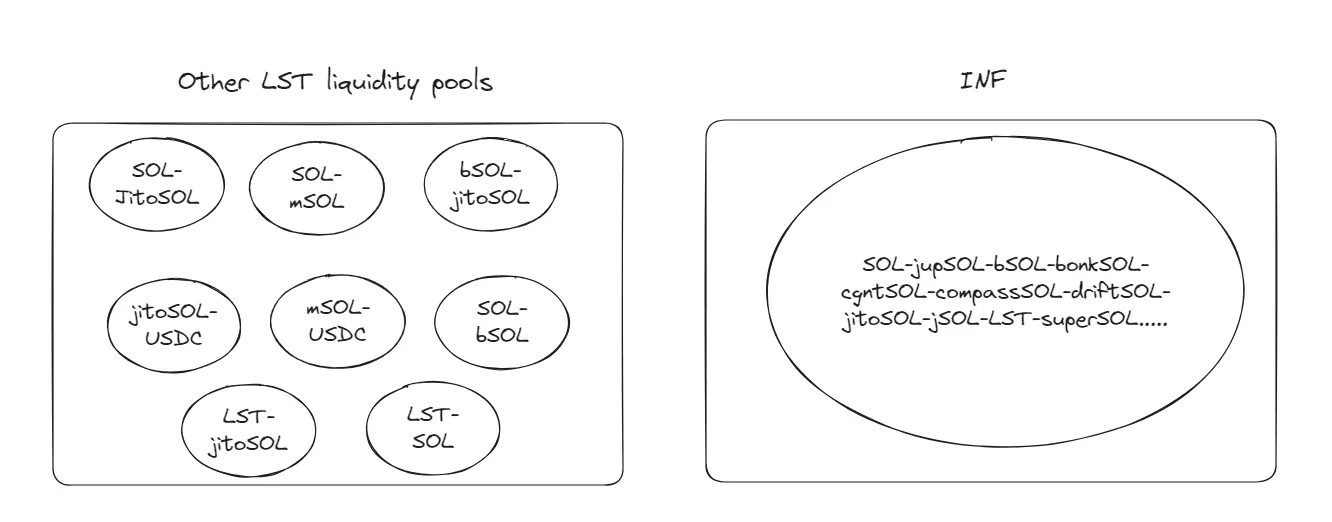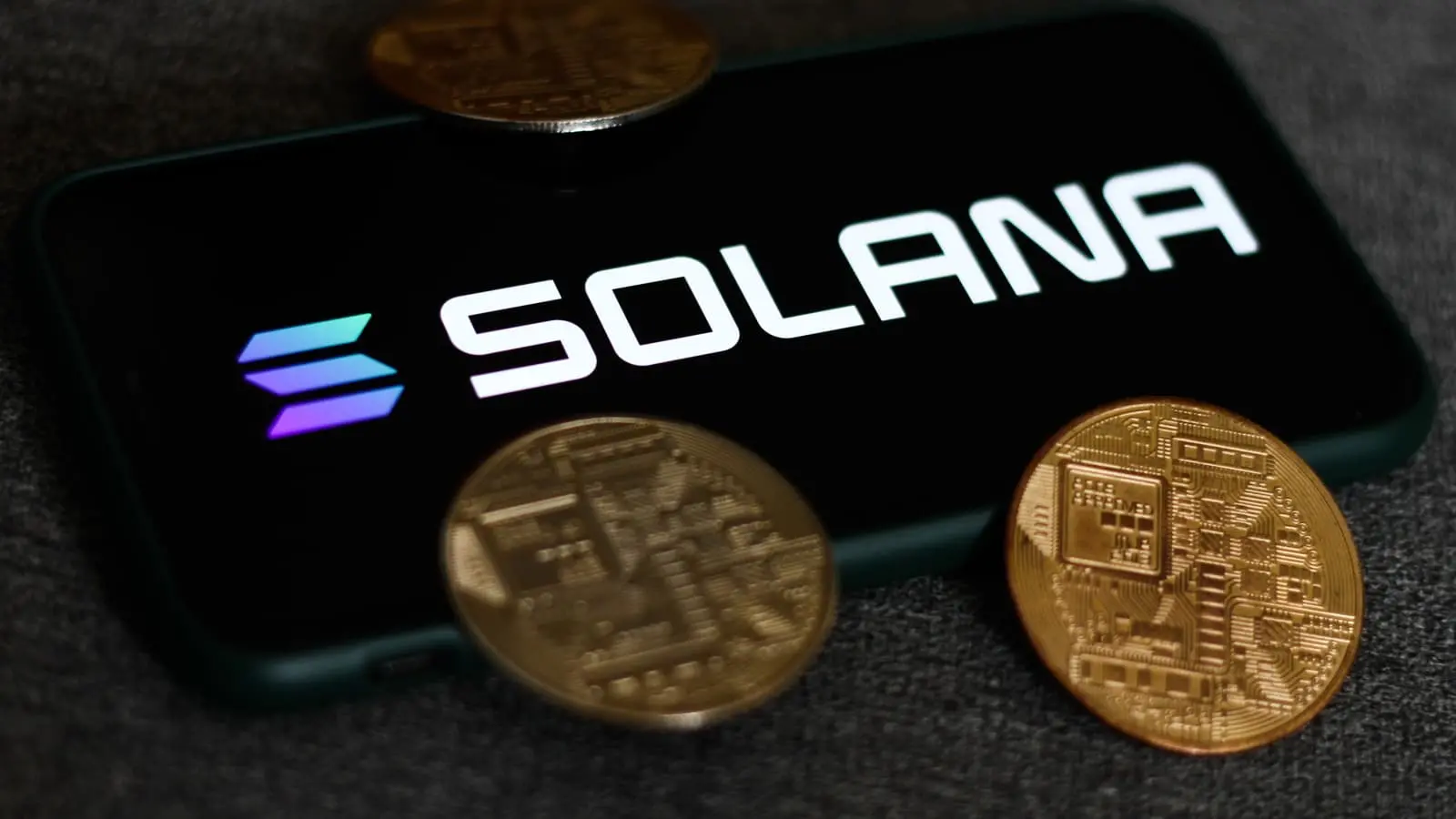INF is shaping a new paradigm for liquid staking on Solana
Introduction
INF has quietly risen in the field of liquid staking (LST) on Solana, accumulating an impressive 1.1 million SOL since its launch a month ago. For reference, INF currently ranks fourth in staking weight, only behind JitoSOL (9.8 million SOL), mSOL (6 million SOL), and bSOL (2.5 million SOL). So, what exactly is INF, and why does the Solana ecosystem so evidently support this new type of LST? This article aims to delve into how INF works and why it leads a new paradigm in liquid staking on Solana.
What is Infinity?

Infinity is a liquidity pool (LP) that supports a variety of liquid staking tokens (LSTs). Most liquidity pools only support two assets (e.g., USDC-SOL), while liquidity pools like Curve's stableswap support three to four assets (e.g., USDC-USDT-DAI). Infinity, on the other hand, supports all whitelisted LSTs (e.g., SOL-jupSOL-bSOL-bonkSOL-cgntSOL-compassSOL-driftSOL, etc.).
There is no limit to the number of LSTs that Infinity can support, which is also the origin of its name. But how does it achieve this? Each LST has different prices and different staking yields. Faced with N assets, there are N*N (N squared) possible pairwise trading situations; how does Infinity ensure fair pricing for all these assets?
Why Do We Need INF?
Unlike the winner-takes-all paradigm observed in Ethereum, we may see a more diversified LST competitive landscape in Solana. The goal of INF is to provide a fairer competitive environment for all LSTs, including new entrants. You can read this article to understand why the liquid staking landscape in Solana is about to change.
How Does Infinity Support So Many LSTs at Once?
Currently, all LSTs provide a delayed unstake instruction that consumes LST tokens and returns SOL or a staking account to the user. We can think of LSTs as a "convenience layer" on the staking account.
The key is to have a secure and reliable on-chain oracle that can tell us the floor price of each LST. The price of each LST can be directly read from the account itself—the ratio of totalLamports to poolTokenSupply.
Here is an example from BlazeStake:
"totalLamports": "2586658749561150",
"poolTokenSupply": "2333532553328205",
In this example, dividing totalLamports by poolTokenSupply gives a result of 1.1084.
This ratio can be viewed as the floor price of the LST. Tokens will continuously accumulate staking rewards over time, so totalLamports will increase at the start of each new epoch.
However, there is a problem—we need to consider the withdrawal fees for LSTs (if any). We can still read this information from the account. For example, bSOL has a fee of 0.10%. Therefore, the "adjusted" ratio is 1.1084 * (1 - 0.001) = 1.1073.
To price trades fairly, we can simply divide the adjusted ratios. For instance, if 1 bSOL = 1.1073 SOL and 1 scnSOL = 1.1758 SOL, then 1 bSOL = 0.9417 scnSOL. This makes sense because, measured in SOL, 1 scnSOL is worth more than 1 bSOL.
Since each LST can be priced relative to SOL as the benchmark currency, this ratio method applies to trading every pair of LSTs. This allows Infinity to price each pair of assets fairly and is how it can support all LSTs simultaneously.
Where Does INF's Revenue Come From?
LSTs are essentially a combination of multiple LSTs, with a configuration strategy of 20% new LSTs (such as jupSOL, bonkSOL, cgntSOL, etc.) and 80% existing LSTs (such as jitoSOL, mSOL, bSOL, etc.). The goal of these LSTs is to provide diversified staking yields and maximize trading volume to achieve a higher overall annualized yield. The configuration of the targets will be directly weighted by TVL. Infinity operates under the assumption that trading volume is proportional to scale, and the team is very aware that trading volume naturally has a concentration effect, so it is important to consider this. If a newly emerged small LST has a large trading volume, they can rebalance the LST ratios for better results.
In short, Infinity's revenue is essentially the weighted average of the staking yields of the LSTs in the pool, plus the trading fees from the INF pool. Revenue will vary based on factors such as the number of LSTs, the trading volume of these LSTs, the pool's TVL, and the TVL of other liquidity pools. Users can fully expect a base staking return rate of about 7.5% (the weighted average of the staking yields of the LSTs in the pool), plus variable returns from trading fees.
Conclusion
Sanctum and INF are expected to capture a significant portion of LST trading volume on Solana in the future due to their capital efficiency compared to standalone asset pools and their ability to accommodate long-tail LSTs. As trading volume increases, we can expect INF's revenue to increase accordingly, and users will have a stronger desire to hold INF rather than individual LSTs.







